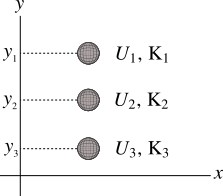We consider a situation in which a ball falls under the action of gravity from a particular height in our Earth-body system. We neglect the air resistance on the ball. There is always a system when we talk about potential energy, for example in our case now it is Earth-body system.
You may know that the change in kinetic and potential energy both are the work done by a force. If the kinetic energy of a body changes from \(K_1\) to \(K_2\), you know from the work-kinetic energy theorem, the work done \(W\) is
\[W = K_2 - K_1 \tag{1} \label{1} = \Delta K\]
Similarly, the potential energy of the body changes from \(U_1\) to \(U_2\), the work done on the body is expressed as the negative of the change in potential energy that is
\[W = -(U_2 - U_1) \tag{2} \label{2} = -\Delta U\]
As the ball falls under the action of gravity, the kinetic energy continuously increases and the potential energy continuously decreases, and the total energy remains the same.
And from Equation \eqref{1} and Equation \eqref{2} we have
\[\begin{align*} \Delta K &= - \Delta U\\ {\rm{or,}}\quad {K_2} - {K_1} &= - ({U_2} - {U_1}) = {U_1} - {U_2}\\ {\rm{or,}}\quad {K_1} + {U_1} &= {K_2} + {U_2} \tag{3} \label{3} \end{align*}\]
The sum of the initial kinetic energy and the initial potential energy is equal to the sum of the final kinetic energy and the final potential energy. The sum of the kinetic energy and the potential energy of a body at any point on its path is called mechanical energy. Hence the total mechanical energy of the ball is constant or conserved as suggested by Equation \eqref{3}.

In Figure 1 a ball falls from the height \(y_1\) and the potential energy of the ball at height \(y_1\) is \({U_1} = mg{y_1}\). The velocity of the ball at height \(y_1\) is zero, so the kinetic energy is zero i.e. \({K_1} =0\). As the ball falls its potential energy decreases and kinetic energy increases. Therefore, \({U_1} > {U_2} > {U_3}\) and \({K_1} < {K_2} < {K_3}\) but from Equation \eqref{3} we have \({K_1} + {U_1} = {K_2} + {U_2} = {K_3} + {U_3}\). The conversation of mechanical energy tells us that the sum of kinetic and potential energy of the ball at every point on its path is constant or conserved that is, the potential energy lost is recovered as the kinetic energy and the sum remains constant.
In our case the force which does work is the gravitational force and it is a conservative force. If a conservative force does work, the mechanical energy is always conserved if no external force does work. For example, friction is not a conservative force as the work done by the friction is never stored as potential energy or recovered back as kinetic energy. What if an external force does work other than the conservative force? If \({W_{{\rm{ext}}}}\) is the external work done by the air resistance on the ball in Figure 1, the work done by this force is equal to the change in total mechanical energy. If \({E_1} = {K_1} + {U_1}\) and \({E_2} = {K_2} + {U_2}\), the work done by the external force is \({W_{{\rm{ext}}}} = {E_2} - {E_1} = \Delta E\). Or we can write Equation \eqref{3} including the work done by the external force as, \[{K_1} + {U_1} + {W_{{\rm{ext}}}} = {K_2} + {U_2} \tag{4} \label{4}\]
The force the air resistance exerts on the ball is in opposite direction of displacement so it does negative work. Therefore, the final mechanical energy is lesser than the initial mechanical energy and \(\Delta E\) is negative.





